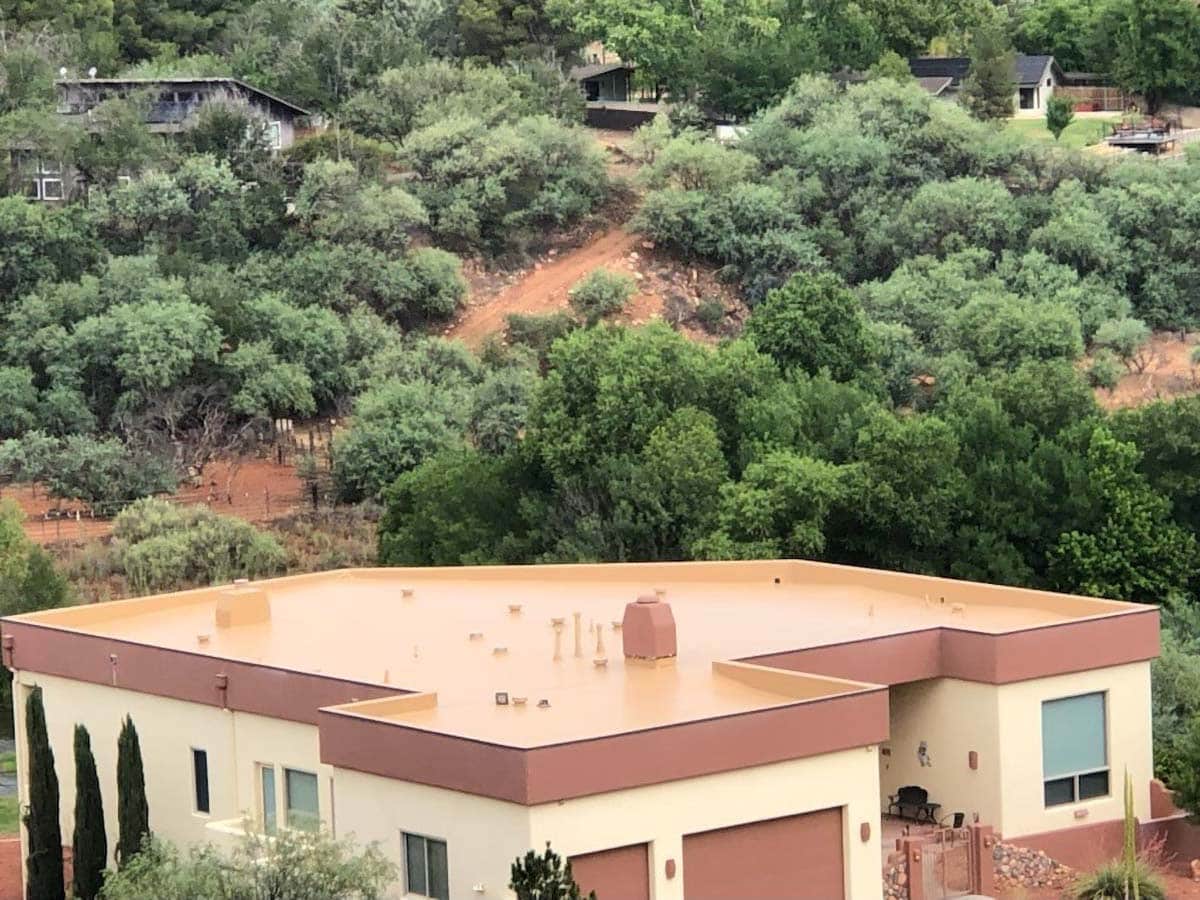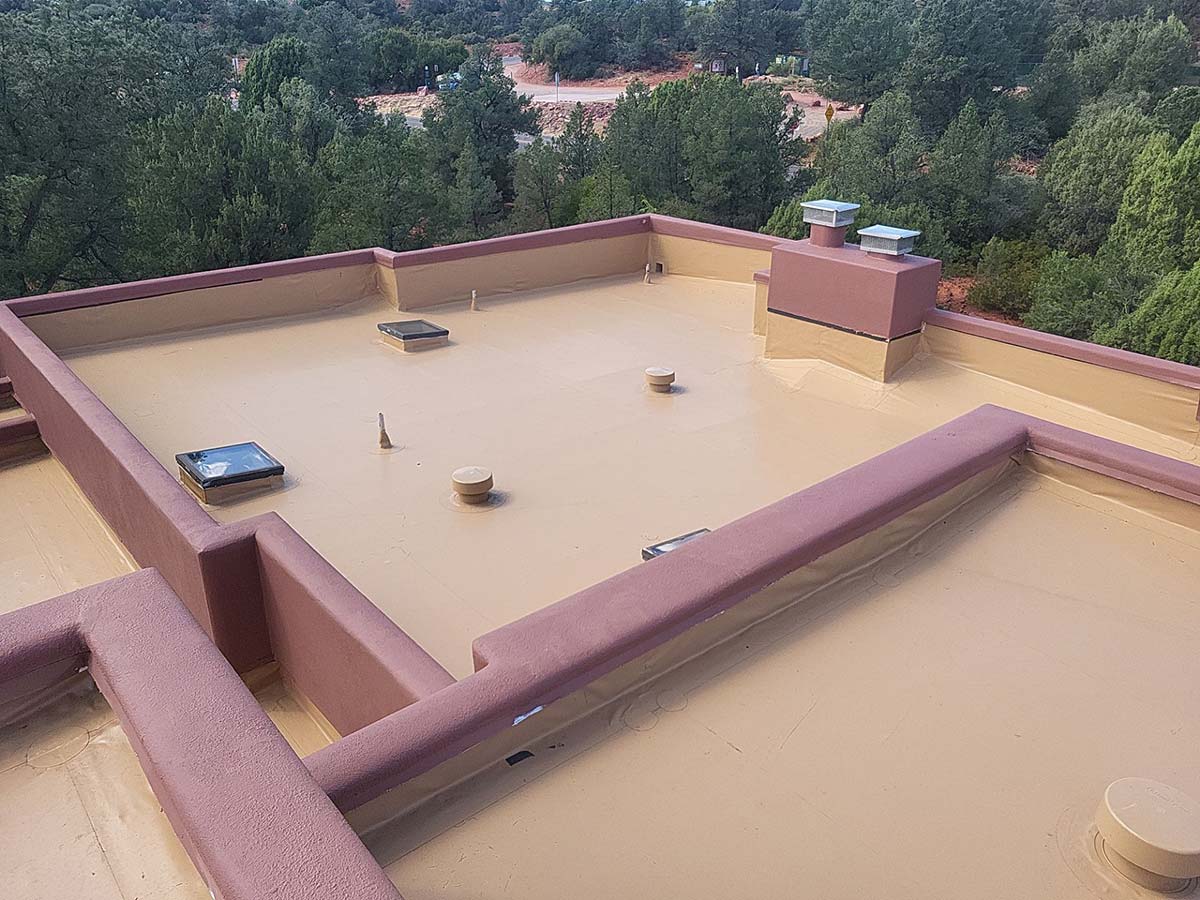Flat roofs are a staple in Arizona architecture, especially in desert climates like Arizona where traditional sloped roofs are not always the most practical option. They have been used for centuries in regions with hot, dry weather, offering a design that naturally keeps buildings cooler. Unlike pitched roofs that shed rain and snow, flat roofs provide a stable and usable surface while reducing material costs and energy consumption. Whether for a residential home or a commercial building, choosing a flat roof can be a financially sound decision.

Why Are Roofs Flat in Arizona?
Arizona’s climate plays a crucial role in the popularity of flat roofs. With intense sun exposure, high temperatures, and minimal rainfall, homeowners and businesses benefit from roofing solutions that prioritize cooling efficiency and cost-effectiveness. A flat roof allows for additional insulation and cooling technologies, keeping the indoor temperature more stable and reducing the reliance on air conditioning.
Beyond energy efficiency, flat roofs offer a practical architectural solution. In urban areas where space is limited, the extra rooftop area can be used for HVAC units, solar panels, or even green spaces. Additionally, flat roofs blend seamlessly with Arizona’s Southwestern architectural style, complementing the adobe and stucco exteriors commonly found in the region.
How Long Do Flat Roofs Last in Arizona?
The lifespan of a flat roof depends largely on the materials used and how well it is maintained. Arizona’s strong UV exposure can cause wear and tear on certain materials over time, but with the right choice, a flat roof can last anywhere from 15 to 30 years or more. The most durable flat roofing options include:
- Polyurethane Foam Roofing: This seamless application provides excellent waterproofing and insulation, lasting 25+ years with proper maintenance.
- Modified Bitumen: A UV-resistant material designed to withstand extreme heat and provide long-term durability.
- Built-Up Roofing (BUR): Composed of layers of tar and gravel, this roofing system offers strong protection against Arizona’s weather conditions.
Regular roof inspections and preventative maintenance can significantly extend a flat roof’s lifespan. Ensuring proper drainage, sealing cracks, and applying reflective coatings can help reduce heat absorption and slow down wear and tear.

The Benefits of Having a Flat Roof in Arizona
1. Energy Efficiency
A well-maintained flat roof enhances energy efficiency by keeping warm air out and reducing the need for excessive air conditioning. Many property owners in Arizona choose reflective coatings or polyurethane foam to minimize heat buildup, helping lower utility bills. Unlike sloped roofs, which can trap heat in attic spaces, flat roofs allow for more direct temperature control inside the home or business.
2. Cost Savings and Lower Construction Costs
Flat roofs require fewer materials and less labor to install compared to pitched roofs, making them a more affordable option. Additionally, they have fewer complex angles and joints, which simplifies installation and reduces the likelihood of costly repairs. Over time, the savings in both initial construction and long-term maintenance make flat roofs an attractive choice for property owners looking for financial efficiency.
3. Fast Installation and Easier Maintenance
Because flat roofs have a simpler structure, they can be installed quickly, allowing property owners to complete their roofing projects with minimal disruption. Routine inspections and maintenance are also easier since roofing contractors can walk directly on the surface to inspect for leaks, debris buildup, or damage from Arizona’s scorching summer months.
Why Do Arizona Houses Have Flat Roofs?
Many homes in Arizona feature flat roofs because they are specifically suited to the region’s weather and construction needs. Unlike other parts of the country where rain and snow require sloped roofs for proper drainage, Arizona’s dry climate allows for flat surfaces without significant risk of water damage. When rain does occur, modern flat roofing systems incorporate drainage solutions such as interior drains, scuppers, and gutters to direct water away from the building efficiently.
Additionally, flat roofs complement the traditional Southwestern aesthetic. Adobe-style homes, which are common throughout the state, often use flat roofs to maintain their historical and cultural authenticity. This architectural style has been used for generations, proving its effectiveness in desert climates.

Types of Flat Roofs in Arizona
Choosing the right roofing material is crucial to ensuring longevity and performance. Some of the most common flat roofing materials include:
1. Polyurethane Foam Roofing
This seamless application provides superior insulation and waterproofing, making it a top choice for energy efficiency and durability.
2. Modified Bitumen
A flexible and UV-resistant material, modified bitumen is designed to withstand Arizona’s extreme temperatures while providing long-lasting protection.
3. Built-Up Roofing (BUR)
BUR consists of multiple layers of waterproof materials topped with gravel, creating a strong, resilient surface that is well-suited for commercial buildings.
4. Rubber Membrane Roofing
This affordable and durable option is known for its flexibility and resistance to environmental damage, requiring minimal maintenance over its lifespan.
Flat Roof Installation Process
Installing a flat roof requires careful planning to ensure maximum durability and efficiency. The process includes:
- Inspection & Preparation: Assessing the existing roof structure and determining the best materials based on the building’s needs.
- Material Application: Laying down the selected roofing material and ensuring a secure, watertight installation.
- Sealing & Waterproofing: Applying protective coatings to enhance durability and minimize leaks.
- Final Inspection: Ensuring the roof meets all quality and safety standards before completing the project.
Durability and Low Maintenance
Flat roofs are known for their low-maintenance requirements, making them a preferred choice for both homeowners and commercial buildings. Regular cleaning to remove debris, routine inspections, and prompt repairs of minor issues can prevent major damage and extend the roof’s lifespan. Many modern flat roofing systems are designed to withstand the elements with minimal upkeep.
Is a Flat Roof Right for Your Home or Business?
Flat roofs offer numerous benefits, from cost savings and energy efficiency to quick installation and easier maintenance. Whether you need a roofing solution for a new construction project or a replacement for an existing roof, a flat roof is an excellent choice for buildings in Arizona’s hot climate.
For expert flat roof installation and maintenance, contact Hahn Roofing today. Our team specializes in high-quality flat roofing systems designed to enhance energy efficiency and reduce cooling costs.
